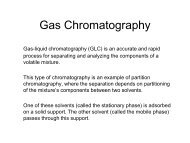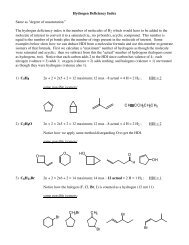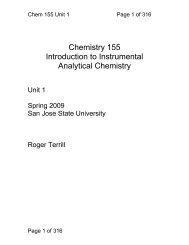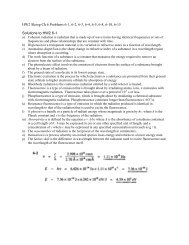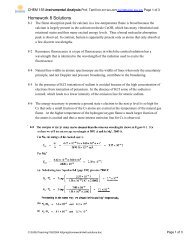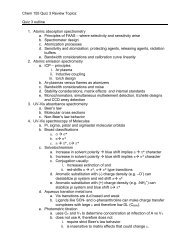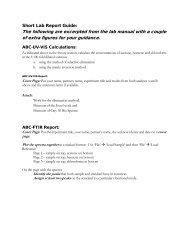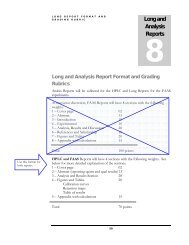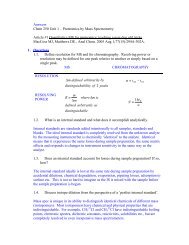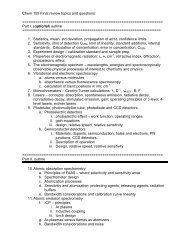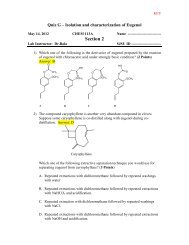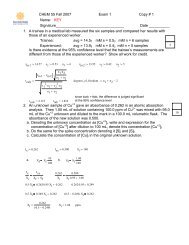Chemistry 55 Lecture and Lab – Quantitative Analysis Fall 2003
Chemistry 55 Lecture and Lab – Quantitative Analysis Fall 2003
Chemistry 55 Lecture and Lab – Quantitative Analysis Fall 2003
You also want an ePaper? Increase the reach of your titles
YUMPU automatically turns print PDFs into web optimized ePapers that Google loves.
<strong>Chemistry</strong> <strong>55</strong> <strong>Lecture</strong> <strong>and</strong> <strong>Lab</strong> – <strong>Quantitative</strong> <strong>Analysis</strong> <strong>Fall</strong> <strong>2003</strong><br />
Instructor: Dr. Roger Terrill Duncan Hall 4B<br />
(408) 924-4970 rterrill@jupiter.sjsu.edu<br />
Prerequisite:<br />
Text:<br />
Office Hours: MW 09:30-10:30 DH 4B<br />
TR 16:30-17:30 DH-4B & appointment<br />
<strong>Lecture</strong> Hours: TR 07:30-08:20 DH-416<br />
<strong>Lab</strong> Hours: MW 13:30-16:20 DH-413<br />
TR 10:30-13:20 DH-413<br />
Chem 1B with a C or better (C- not accepted).<br />
<strong>Quantitative</strong> Chemical <strong>Analysis</strong>; 6 th ed. By Daniel Harris, – required – available<br />
in Spartan Bookstore. Supplementary material at www.whfreeman.com/qca<br />
<strong>Lab</strong> Manual: <strong>Quantitative</strong> <strong>Analysis</strong> <strong>Lab</strong>oratory; S.P. Perone – required – available in the lab<br />
or via SAACS, DH 504, during business hours the first two weeks of the<br />
semester.<br />
<strong>Lab</strong> Notebook: An acceptable laboratory notebook, with carbon copy pages, will be<br />
required for all students. Notebook carbons will be due at the conclusion of<br />
each day of lab. All primary data must be taken in the notebook in ink. In<br />
many industry or research situations, the lab notebook can be used as a legal<br />
document, so good notebook habits are essential for success in science!<br />
Notebooks can be purchased in Spartan or Robert’s bookstore on 10 th street. It<br />
is fine with me if you use part of an old notebook or one in use for another<br />
class.<br />
Exercises: In this course we will: a. discuss quantitative chemical analysis, statistics <strong>and</strong><br />
error analysis, chemical equilibria, acid-base <strong>and</strong> buffer chemistry, basic<br />
spectrophotometry <strong>and</strong> chromatography b. conduct lab experiments in<br />
acid/base <strong>and</strong> EDTA titrimetry, flame <strong>and</strong> solution photometry, electrochemistry<br />
<strong>and</strong> high performance liquid chromatography.<br />
Content:<br />
Exams:<br />
The lecture will cover material from chapters, the latter time permitting:<br />
0,1,2, 3, 4, 6, 7, 8, 10, 11, 12, 14, 15, 18, 21, 22, 23, 24, 25. The pace <strong>and</strong><br />
timing of the lecture, including suggested homework problems will be<br />
determined during the semester. Anticipate about 1 week per chapter.<br />
Tuesday Thursday Tuesday Thursday<br />
8/26 Intro 8/28 10/21 10/23<br />
9/2 9/4 Quiz 1 10/28 10/30 Quiz 3<br />
9/8 9/8 11/4 11/6<br />
9/16 9/18 Exam 1 11/11 11/13 Exam 4<br />
9/23 9/25 11/18 11/20<br />
9/29 10/1 Quiz 2 11/25 Quiz 4 11/27 Holiday<br />
10/7 10/9 12/2 12/4<br />
10/14 10/16 Exam 3 12/9 12/11 Finals<br />
Page 1 of 5
<strong>Chemistry</strong> <strong>55</strong> <strong>Lecture</strong> <strong>and</strong> <strong>Lab</strong> – <strong>Quantitative</strong> <strong>Analysis</strong> <strong>Fall</strong> <strong>2003</strong><br />
Grading:<br />
A single letter grade will be assigned for CHEM <strong>55</strong>. The lecture <strong>and</strong> the<br />
laboratory portions of the course carry roughly equal weights. A passing grade<br />
in CHEM <strong>55</strong> requires a passing grade in both the lecture <strong>and</strong> the laboratory<br />
portions of the course.<br />
<strong>Chemistry</strong> <strong>55</strong> <strong>Lecture</strong> <strong>and</strong> <strong>Lab</strong>oratory Points<br />
Maximum<br />
<strong>Lab</strong>oratory<br />
*Chloride, w/w % gravimetry 100<br />
*ppm Total Hardness, by EDTA titration 100<br />
*Ca <strong>and</strong> Mg, w/v % 100<br />
Certification of either Mn, Zn, or Co solution 30<br />
Calibration of pH electrode 20<br />
*H 3 PO 4 <strong>and</strong> NaH 2 PO 4 , w/v %, by titrimetry 200<br />
Directions for preparing 500 mL of pH 7.0 buffer solution 20<br />
Mn in steel, w/w %, by photometry (Spec 20) 50<br />
By AAS, calibration curve 50<br />
By AAS, st<strong>and</strong>ard addition 50<br />
Calibration of Cl - electrode 20<br />
Chloride, w/w %, in KCl <strong>and</strong> NaCl mixture by ISE 100<br />
Polyaromatic hydrocarbons, mg/mL in a mixture by HPLC 100<br />
Calibration of an instrument (Spec 20, AAS, or HPLC) 30<br />
Total Possible 970<br />
Multiply above by 0.4639 450<br />
Notebook 50<br />
Quizzes Total possible points times a factor equal to 125<br />
Technique, etc. 25<br />
<strong>Lab</strong> total possible 650<br />
<strong>Lecture</strong><br />
3 Hour exams 300<br />
Final 250<br />
5 Quizzes 100<br />
<strong>Lecture</strong> total possible 650<br />
Gr<strong>and</strong> Total 1300<br />
Page 2 of 5
<strong>Chemistry</strong> <strong>55</strong> <strong>Lecture</strong> <strong>and</strong> <strong>Lab</strong> – <strong>Quantitative</strong> <strong>Analysis</strong> <strong>Fall</strong> <strong>2003</strong><br />
<strong>Lab</strong>oratory Activities for <strong>Fall</strong> <strong>2003</strong><br />
1. Check-in <strong>and</strong> preliminary operations<br />
a) View film concerning laboratory safety: safety quiz.<br />
b) Become proficient in the use of analytical balances.<br />
c) Quiz on basic algebra, logarithms, <strong>and</strong> chemistry.<br />
2. Gravimetric determination of chloride in a solid sample. SILVER IS COSTLY. Put<br />
excess 5% AgNO 3 solution as well as solid AgCl in bottles provided. Do not save<br />
wash solutions. Report results by September 18 th .<br />
3. Preparation of st<strong>and</strong>ard EDTA solution.<br />
4. EDTA determination of total hardness, calcium <strong>and</strong> magnesium in a brine sample.<br />
5. Certification of a reagent solution (Mn, Zn, or Co) by EDTA titration.<br />
6. Preparation <strong>and</strong> st<strong>and</strong>ardization of 0.1 M NaOH.<br />
7. Calibration of pH electrode.<br />
8. Potentiometric titration of a mixture of phosphoric acid <strong>and</strong> sodium dihydrogen<br />
phosphate.<br />
9. Submit explicit directions for the preparation of 500 mL of 0.050 M pH 7.0<br />
phosphate buffer solution. Use activity coefficients. Report by October 19 th .<br />
10. Spectrophotometric determination of manganese in steel.<br />
11. Manganese determination by atomic absorption spectroscopy using both<br />
calibration curve <strong>and</strong> st<strong>and</strong>ard addition procedures.<br />
12. Calibration of chloride ion selective electrode.<br />
13. Determination of chloride in a mixture by direct potentiometry.<br />
14. Determination of components of a mixture of polyaromatic hydrocarbons by high<br />
performance liquid chromatography.<br />
15. Checkout of locker by Dec. 10. Students failing to check out officially will be<br />
charged a fee for the service center to check out the lockers.<br />
Page 3 of 5
<strong>Chemistry</strong> <strong>55</strong> <strong>Lecture</strong> <strong>and</strong> <strong>Lab</strong> – <strong>Quantitative</strong> <strong>Analysis</strong> <strong>Fall</strong> <strong>2003</strong><br />
Your lab notebook table of contents should have at least the following entries:<br />
EXPERIMENT<br />
Page<br />
Gravimetric Chloride Determination…………………………………xx<br />
Preparation of St<strong>and</strong>ard EDTA Solution……………………………xx<br />
Hardness by EDTA Titration…………………………………………xx<br />
Ca <strong>and</strong> Mg by EDTA Titration……………………………….……… xx<br />
Certification of a Solution Concentration by EDTA Titration……. xx<br />
Preparation <strong>and</strong> St<strong>and</strong>ardization of NaOH Solution xx<br />
Calibration of pH Electrode<br />
xx<br />
Determination of H 3 PO 4 <strong>and</strong> NaH 2 PO 4 in a Mixture<br />
xx<br />
Directions for preparing pH 7.00 Buffer solution<br />
xx<br />
Determination of Manganese in Steel by: Photometry<br />
xx<br />
AAS, Calibration Curve<br />
xx<br />
AAS, St<strong>and</strong>ard Addition<br />
xx<br />
Instrument Calibration Record<br />
xx<br />
Calibration of Cl- Electrode…………………………………………. xx<br />
Potentiometric Determination of Chloride by ISE………………… xx<br />
<strong>Analysis</strong> of a Polyaromatic Hydrocarbon Mixture by HPLC………xx<br />
Please note: you must also record the data for: 1) Certification of Solution, 2) pH<br />
Electrode Calibration, 3) Cl Electrode Calibration, <strong>and</strong> 4) Major Instrument Calibration<br />
in the appropriate record book, as well as in your notebook.<br />
Page 4 of 5
<strong>Chemistry</strong> <strong>55</strong> <strong>Lecture</strong> <strong>and</strong> <strong>Lab</strong> – <strong>Quantitative</strong> <strong>Analysis</strong> <strong>Fall</strong> <strong>2003</strong><br />
ADDENDUM TO ALL CHEMISTRY DEPARTMENT GREENSHEETS<br />
(Except Chem 291 Sections)<br />
Revised August 2002<br />
CHEMICAL SAFETY – all courses<br />
Chem 120S is a required course for all chemistry majors <strong>and</strong> minors <strong>and</strong> a prerequisite for all<br />
Chem 180/298 research.<br />
EMERGENCIES AND EVACUATIONS – all courses<br />
If you hear a continuously sounding alarm, or are told to evacuate by Emergency Coordinators<br />
(colored badge identification), walk quickly to the nearest stairway (end of each hall). Take<br />
your personal belongings, as you may not be allowed to immediately return. Follow<br />
instructions of Emergency Coordinators. Be quiet so you can hear. Once outside, move<br />
away from the building. Do no return to the building unless the Police or Emergency<br />
Coordinators announce that you may.<br />
DISABLED STUDENTS – all courses<br />
Any student with a pre-existing disability requiring an accommodation (as documented by the<br />
Disability Resource Center) should make this need known to the instructor during the first two<br />
weeks of classes. Every effort will be made to accommodate your needs.<br />
ACADEMIC DISHONESTY – all courses<br />
Academic dishonesty of any sort will subject the involved person(s) to university m<strong>and</strong>ated<br />
consequences. You should be familiar with the section of the SJSU Catalog entitled “Policy of<br />
Academic Dishonesty” (pp.448-449 in the 2002/04 Catalog). Incidents of academic<br />
dishonesty may be referred to the Chief Judicial Affairs Officer of the University <strong>and</strong> reports<br />
may be placed in Department <strong>and</strong> /or University files.<br />
For courses with written assignments include:<br />
Note in particular that plagiarism, word-for-word copy of another person’s words without proper<br />
attribution (quotation marks <strong>and</strong> a clear literature reference), is a particularly serious form of<br />
academic dishonesty.<br />
LABORATORY SAFETY – all laboratory courses<br />
You should read the safety section of the SJSU Catalog under <strong>Chemistry</strong> Department (page<br />
136 of current 2002/04 Catalog). Note in particular: “Failure to comply with proper procedures<br />
<strong>and</strong> prescribed safety cautions shall subject the student to disciplinary action. 1) Any student<br />
who engages in unauthorized experimentation, or who seriously disregards safety, thereby<br />
endangering self or others shall be withdrawn immediately from the class with a grade of F. 2)<br />
Any student who show persistent disregard for safety may have his/her grade lowered, <strong>and</strong><br />
may risk being withdrawn with a final grade of F.”<br />
Page 5 of 5



